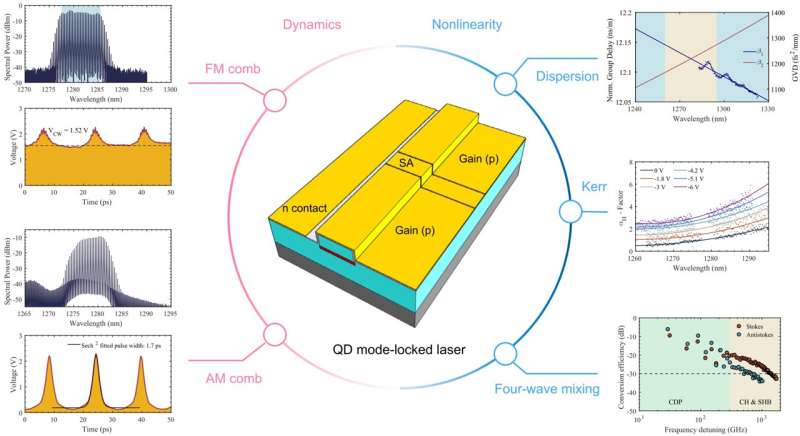Scientist develop a broadband quantum-dot frequency-modulated comb laser

Since the conception of the laser frequency comb in the late 1990s, it has revolutionized the precise measurement of frequency and time. Beyond their initial use in optical clocks and precision spectroscopy, optical frequency combs (OFCs) have exhibited strong potential for various applications, including ultraviolet and infrared (IR) spectroscopy, remote sensing, optical frequency synthesis, and high-speed optical communications.
However, the strong optical pulses delivered by an amplitude-modulated (AM) OFC are not favorable to dense wavelength-division multiplexing (DWDM) systems in which many microring modulators are deployed. This is because the high instantaneous power of optical pulses would result in strong thermal nonlinearities.
On the other hand, the formation of a broadband OFC relies on careful engineering of the group velocity dispersion (GVD) of the waveguide, which is challenging for platforms where the GVD is mainly determined by the material. Hence, the system size, weight, power consumption, and cost (SWaP-C) of OFCs must be improved for the use of OFCs in industry.
In a new paper published in Light: Science & Applications, a team of scientists, led by Professor John Bowers from the Institute for Energy Efficiency, University of California, Santa Barbara, USA, has developed a frequency-modulated (FM) comb based on advanced quantum-dot (QD) laser. A proper laser cavity design enables a record 3-dB optical bandwidth of 2.2 THz in the Telecom O-Band.
The channel spacing is as large as 60 GHz, which is beneficial for eliminating the channel crosstalk in data transmission. More interestingly, this quasi-continuous-wave FM comb does not deliver strong optical pulses, which is favorable to an integrated DWDM system.
By taking advantage of the QD laser, the broadband FM comb is generated from a 1.35 mm-long and 2.6 um-wide laser cavity, along with a high wall-plug efficiency of over 12%. Compared to other integrated OFC technologies, the reported FM comb based on QD laser exhibits a superior SWaP-C, which is a solution being pursued by both academia and industry.
The remarkable material properties of QD make it a promising platform for FM comb generation. The ultrafast gain dynamics allow for giant Kerr nonlinearity and four-wave mixing, which makes the QD laser a better candidate for FM comb generation in the Optical Communication Band than the conventional quantum-well diode lasers.
Importantly, this reported approach allows us to improve the optical bandwidth without the need for careful engineering of the waveguide dispersion. This achievement is realized by the engineering of Kerr nonlinearity, which can be simply controlled by a voltage applied to the saturable absorber section of the laser. As such, this approach reduces the challenges in the fabrication process. These scientists comment on their achievements in this work:
“This is an evolution of thinking. The first mode-locked laser was demonstrated in 1963, huge progress has been made since then. It used to be thought that a mode-locked laser must deliver strong optical pulses because of its AM (amplitude-modulation) nature. However, we demonstrate that it doesn’t have to. The FM (frequency-modulated) mode-locked laser is experiencing a renaissance. It is its nature to deliver a broadband and flat-topped spectrum along with a quasi-continuous-wave emission.”
“Despite the demonstration of FM combs in mid-infrared quantum cascade lasers, the FM nature of near-infrared QD mode-locked lasers was not fully exploited. We are trying to understand it and apply the FM mode-locked laser to high-speed PICs (photonic integrated circuits) for data centers,” they added.
“The presented technique addresses the issues that an OFC encounters on PICs and it is compatible with the mature CMOS industry. Our findings give novel insights into the improvement of FM mode-locked lasers for PICs. This breakthrough could open a new venue for the next generation of PICs for 5G/6G communication, artificial intelligence, and autonomous driving,” the scientists say.
More information:
Bozhang Dong et al, Broadband quantum-dot frequency-modulated comb laser, Light: Science & Applications (2023). DOI: 10.1038/s41377-023-01225-z
Citation:
Scientist develop a broadband quantum-dot frequency-modulated comb laser (2023, July 27)
retrieved 27 July 2023
from https://phys.org/news/2023-07-scientist-broadband-quantum-dot-frequency-modulated-laser.html
This document is subject to copyright. Apart from any fair dealing for the purpose of private study or research, no
part may be reproduced without the written permission. The content is provided for information purposes only.
For all the latest Science News Click Here
For the latest news and updates, follow us on Google News.

